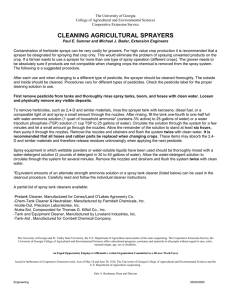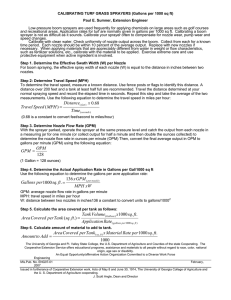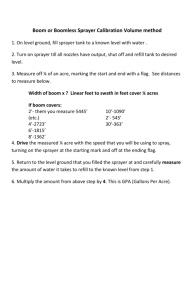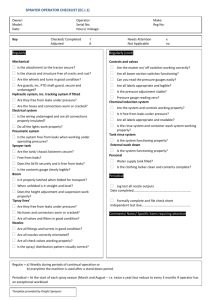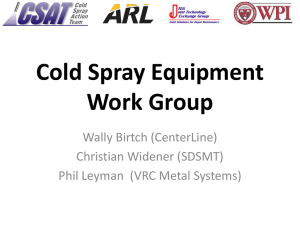Pecan Orchard Air Blast Sprayers
advertisement
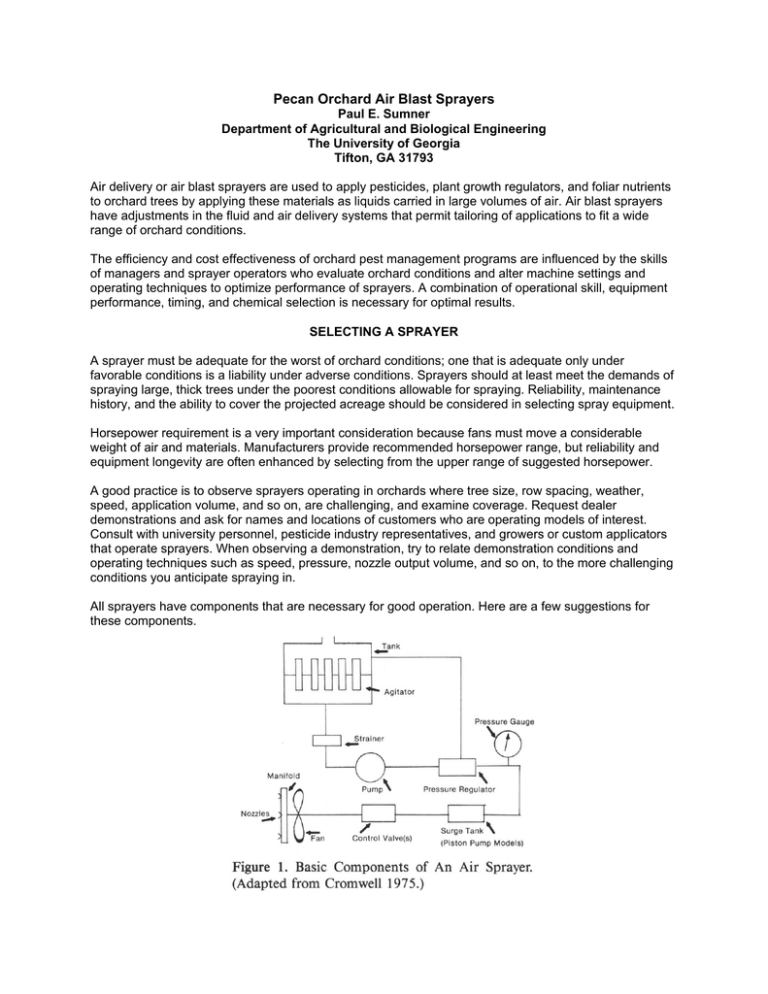
Pecan Orchard Air Blast Sprayers Paul E. Sumner Department of Agricultural and Biological Engineering The University of Georgia Tifton, GA 31793 Air delivery or air blast sprayers are used to apply pesticides, plant growth regulators, and foliar nutrients to orchard trees by applying these materials as liquids carried in large volumes of air. Air blast sprayers have adjustments in the fluid and air delivery systems that permit tailoring of applications to fit a wide range of orchard conditions. The efficiency and cost effectiveness of orchard pest management programs are influenced by the skills of managers and sprayer operators who evaluate orchard conditions and alter machine settings and operating techniques to optimize performance of sprayers. A combination of operational skill, equipment performance, timing, and chemical selection is necessary for optimal results. SELECTING A SPRAYER A sprayer must be adequate for the worst of orchard conditions; one that is adequate only under favorable conditions is a liability under adverse conditions. Sprayers should at least meet the demands of spraying large, thick trees under the poorest conditions allowable for spraying. Reliability, maintenance history, and the ability to cover the projected acreage should be considered in selecting spray equipment. Horsepower requirement is a very important consideration because fans must move a considerable weight of air and materials. Manufacturers provide recommended horsepower range, but reliability and equipment longevity are often enhanced by selecting from the upper range of suggested horsepower. A good practice is to observe sprayers operating in orchards where tree size, row spacing, weather, speed, application volume, and so on, are challenging, and examine coverage. Request dealer demonstrations and ask for names and locations of customers who are operating models of interest. Consult with university personnel, pesticide industry representatives, and growers or custom applicators that operate sprayers. When observing a demonstration, try to relate demonstration conditions and operating techniques such as speed, pressure, nozzle output volume, and so on, to the more challenging conditions you anticipate spraying in. All sprayers have components that are necessary for good operation. Here are a few suggestions for these components. Tanks for sprayers should be corrosion-resistant and designed for ease in filling, adding pesticides, and for rapid complete drainage to facilitate cleaning. Agitation should be sufficient to keep all materials uniformly distributed throughout the tank. Wettable powder pesticide formulations require vigorous agitation. Paddle or propeller type mechanical agitators and hydraulic jet agitators are common. Regardless of design, thorough agitation is required, both when trees are being sprayed and when spray nozzles are shut off. Settling of pesticides in tank mixtures may cause spray equipment problems and reduce pesticide effectiveness. Pumps for orchard sprayers are usually piston or centrifugal type units. Centrifugal pumps move a high volume of liquid at low to medium pressure. Piston pumps are usually selected for high pressure applications. Pressure Regulators are variable orifice devices that are opened or closed to change system pressure. With air blast sprayers, pressure regulators are primarily used to divert varying amounts of the pump output back to the tank. They are often referred to as pressure relief valves or unloading valves. Actual spray output is seldom governed by pressure regulators on air blast sprayers. Spray pressure is sometimes regulated by varying pump speed, and it can also be regulated by varying engine RPM. Accordingly, it is very important to maintain consistent engine speed so the RPMs of the sprayer PTO remain in the range needed. Pressure Gauges are monitors of spray system operation. Experienced operators will quickly observe spray system malfunctions that visibly reduce spray output and pattern. However, malfunctions that result in 10 to 20 percent changes in spray output may easily go unnoticed. Pressure gauges indicate spray manifold pressure. Because a sprayer is set up to operate within a specified pressure range, the pressure gauge should alert the operator when a malfunction has changed manifold pressure. Malfunctions can arise from restricted or clogged strainers (particularly line strainers), restricted or leaking lines, changes in pump output, pressure regulator malfunctions, and so on. Control Valves may simply be an off/on valve but, most often, they provide manifold selection options. Valves may be manually operated or operated by electric solenoids. Valve controls should be mounted within easy reach of the operator. Manifolds deliver spray to nozzles and typically allow selective nozzle placement to achieve the desired spray pattern. Spray Nozzles meter spray liquid and atomize the spray (influencing droplet size and the number of droplets obtained from a given volume of liquid). Nozzle type and location also influence spray pattern. Nozzles usually have several components, including a body, cap, strainer, disc and core (orifice and whirl plate). The disc and core, or tip, are quite susceptible to wear. Wear resistant and chemical corrosion resistant materials, such as hardened stainless steel, tungsten carbide, or ceramic material, are usually selected. Even so, nozzle output should be checked periodically and adjustments made for nozzle wear, as even a small amount of wear can significantly increase flow. For example, the flow rate of a D6 disc is increased 36 percent with only 0.005 of an inch of wear. Fans, both axial and centrifugal, are used on air blast sprayers. The airstream’s major function is moving spray into trees and enhancing the uniformity of pesticide deposition on fruit, foliage, and wood. Air movement also displaces leaves and branches, which aids spray penetration and increases the exposure of surfaces to spray. The air stream assures spray droplet velocity, which increases impingement (sticking) of very small spray droplets to the target. The air stream conveys the spray into the tree canopy and helps atomize the spray. Some systems depend on the air stream for atomization, although most sprayers depend primarily on nozzles. The effect of the air stream on spray droplet size is proportional to the relative velocity difference between the liquid spray and the air stream. The greater the velocity difference, the greater the atomization. Thus, if the nozzle injects spray into the air stream moving in the same direction as the air, the spray droplet break-up caused by the air forces will be minimal. Injecting spray directly into (against) the air stream produces the maximum degree of atomization. Air stream characteristics that influence coverage include air volume (CFM: cubic feet per minute) and velocity (FPM: feet per minute). These parameters are influenced by fan type and speed, size, volute design, and so on. As these and previous comments indicate, a number of factors, most being interactive rather than independent, are involved in air delivery sprayer performance. Performance data concerning many of these factors for specific sprayers are not generally available. SPRAYER SETUP Setup of an air blast sprayer includes selection and placement of nozzles, orienting air director vanes and other air control devices, and setting pressure, throttle and engine speed, and so on. Nozzle arrangement and air guide or director vane settings should place most of the spray in the top half of trees, where most of the foliage and fruit are located. Air blast sprayers are typically set up to apply 2/3 to 3/4 of the spray to the top half of trees, and 1/3 to 1/4 to the bottom half (Figure 2). This targeted spraying is accomplished by placing more or larger nozzles on manifolds in the area that supplies spray to the upper half of trees and setting the air directors on the fan outlet to direct the air stream accordingly. Tree growth and target pest habits should be considered in determining the setup for specific applications. Nozzle selection decisions influence the gallons of spray per acre that will be applied and sprayer speed. Orchard spray volumes vary from 30 to 150 gallons per acre (GPA). Below is a recommended application rate based on tree size. Sprayer speeds range from one to three miles per hour, most commonly 1.5 to 2.0 miles per hour (MPH). Better coverage is obtained at the lower speeds and at wind speeds below 5 miles per hour. Table 1. Recommended total spray volume of application for pecan. Tree Height (feet) Total Volume (Gallons per Acre ) Up to 25 25 25 to 50 50 to 90 50 and Up 100 to 150 Other items that must be determined are spray system pressure (PSI), the number of nozzles on the sprayer, and the tree row spacing. Manufacturers usually recommend operation within a specified pressure range, normally 60 to 260 PSI for sprayers with conventional hydraulic nozzles. Many manufacturers also provide nozzle setup suggestions. Sprayer setup decisions are made using information from pesticide labels, operator manuals, extension recommendations, anticipated orchard conditions, and experience. Factors can be listed as known and unknowns. Known will include: (1) GPA (gallons per acre) desired (2) PSI (pounds per square inch) pressure desired (3) MPH (miles per hour) desired (4) Number of nozzles on sprayer (5) Tree row spacing (6) Spraying one or both sides of the sprayer The information that needs to be determined and set for the machine can be listed as unknowns: (1) GPM (gallons per minute) output needed (2) Nozzles (sizes and placement) Gallons per minute output for a sprayer traveling between each row and spraying from both sides can be calculated with the following equation: GPM = GPA × MPH × Row Spacing ( ft ) 500( spraying both sides ) Gallons per minute output for a sprayer traveling between each row and spraying from one side only and both sides of the tree can be calculated with the following equation: GPM = GPA × MPH × Row Spacing ( ft ) 1000( spraying one side) Nozzle sizes can be selected from the manufacturer’s catalogues using the calculated GPM, the selected pressure (PSI), and number of nozzle positions on the sprayer. Arrange nozzles so that 2/3 to 3/4 of the spray will be applied to the top half of trees, with the residual applied to the bottom half. Calculating the average nozzle output will help in making nozzle selections from the manufacturer’s tables. Example: Known (1) GPA = 100 (2) PSI = 150 at the manifold (3) MPH = 1.5 (selected travel speed) (4) Number of nozzles = 16 (5) Tree row spacing = 60 feet (6) Spraying out one side of sprayer both sides of tree Unknowns (1) Gallons per minute output needed GPA × MPH × Row Spacing ( ft ) 100 × 1.5 × 60 9000 = = 1000( spraying one side) 1000( spraying one side) 1000( spraying one side) GPM = 9 Total GPM = (2) Nozzles (sizes and placement). There are 16 on each side. Select 16 nozzles that have a combined output of 9 GPM/side. Arrange nozzles to provide the desired volume in the top half of trees for one side, and then select nozzles for bottom half. Determine the average nozzle output as a starting point for making nozzle selections from the manufacturer's tables. This can be calculated as follows: 9 GPM = 0.56 GPM / Nozzle 16 Nozzles To place 3/4 of the spray volume in the top half of trees, the nozzles placed on the top half of each manifold will need a combined output between 3/4 X 9 GPM = 6.75 GPM. Use the manufacturer’s table to find 16 nozzles having a combined capacity of approximately 9 GPM that can be mounted on the sprayer manifold, with between 6 and 6.75 GPM applied to the top half of trees. Most spray nozzle manufacturers publish tables showing the GPM capacity of various nozzle sizes for various pressures. Table 2 is part of a manufacturer’s nozzle capacity table. Two or more nozzle sizes are normally required to produce the desired spray volume and pattern. A variety of nozzle arrangements can be used to achieve the volume and spray distribution needed. A good selection would be as follows (Figure 3). Figure 3. Nozzle placement for proportioning spray material on each manifold. Top Tree Half (1) D7-45 tip = (1 X 1.35) = (2) D6-45 tips = (2 x 1.15) = (2) D5-45 tips = (2 X 0.86) = (2) D4-45 tips = (2 X 0.68) = Bottom Tree Half (1) D5-45 nozzles = (1 X 0.86) = 1.35 GPM 2.30 GPM 1.72 GPM 1.36 GPM 6.73 GPM/side or 75% 0.86 GPM (2) D4-45 nozzle = (2 X 0.68) = 1.36 GPM 2.22 GPM or 25% AIR BLAST SPRAYER CALIBRATION Calibration is the process of measuring and adjusting the gallons per acre of spray actually applied. Sprayers need to be calibrated to meet the coverage needs of the orchards to be sprayed and to facilitate precise dosing of each material. A sprayer should be set up to apply a gallon per acre rate at a desired speed and pressure. In-orchard calibration frequently indicates a need for adjustments to achieve the target gallons per acre. Speed of travel of a sprayer is a vital factor in obtaining the number of gallons of spray per acre desired. Change in gallons per acre (GPA) applied is inversely proportional to the change in speed. If speed is doubled, the gallons per acre will be halved. Thus, if nozzles have been installed and pressure set to provide a gallon per acre rate at a certain speed, the sprayer should apply the GPA rate at that speed. Using Table 3, measure and mark a distance of 300 feet in the orchard or an area that is similar to the orchard (plowed, fallowed ground, sod, etc.). Find the desired speed in miles per hour (MPH) in the speed column of the table and read the number of seconds required to travel 300 feet on the same line in the seconds per 300 feet column. For example, for a speed of three MPH the number of seconds required to travel 300 feet is 68. Adjust throttle and/or gear selection until 300 feet is traveled in 68 seconds. Table 4 gives the distance that is traveled in one minute at various speeds. To use this table, select desired speed in the MPH column and read the number of feet that must be traveled in one minute from the feet traveled per minute column. Measure and mark the number of feet that must be traveled per minute in the orchard or a similar area (plowed, fallowed, sod, etc.). For example, if you want to spray at 3 MPH, measure and mark a distance of 264 feet. Adjust the sprayer throttle and/or transmission until this distance is traveled in one minute. The speed will be 3 MPH. When using either table, be sure that the speed is uniform for the entire distance that must be traveled. The sprayer should be moving at the desired speed at both ends of the measured distance. Check Gallons Per Minute Output The gallons per minute output required for a sprayer traveling along both sides of each row spraying from one side for a desired gallon per acre rate can be calculated with the following equation: GPM ( req) = GPA × MPH × Row Spacing ( ft ) 1000( spraying one side) (If one pass is made between rows spraying from both sides of the sprayer, use 500 as constant.) GPA = Gallons Per Acre MPH = Miles Per Hour To check actual output: 1. Fill sprayer with water. Note level of fill. If a material with considerably different flow characteristics than water is to be sprayed fill the sprayer with this material. 2. Operate the sprayer at the pressure that will be used during application for a measured length of time. A time period of several minutes will increase accuracy over a time period of 1 minute. 3. Measure the gallons of liquid required to refill sprayer to the same level it was prior to the timed spray trial with the sprayer in the same position as when it was filled initially. The actual GPM can be calculated as follows: GPM ( actual ) = Gallons required to refill sprayer Minutes of spray time 4. Calculate the GPA being applied by the sprayer. GPA = GPM ( actual ) × 1000( spraying from one side) MPH × Row Spacing ( ft ) If the actual GPA is slightly different from the required GPA, the actual GPA can be increased or decreased by increasing or decreasing spray pressure on sprayer models that have provisions for adjusting pressure. Only small output changes should be made by adjusting pressure. Major changes in output should be done by changing nozzles. REFERENCES Cromwell, R. R. 1975. Citrus growers’ guide to air spraying. Florida Cooperative Extension Service Circular 351. p. 31. Table 2. Nozzle Capacity Data. Disc and Core Nozzles D3-23 Liquid Pressure in P.S.I. 40 60 80 100 150 250 400 Capacity in G.P.M. Per Nozzle .12 .14 .16 .18 .21 .26 .32 D3-25 40 60 80 100 150 250 400 .19 .23 .26 .29 .35 .44 .55 D3-45 40 60 80 100 150 250 400 .23 .28 .33 .36 .44 .56 .71 D4-25 40 60 80 100 150 250 400 .29 .35 .40 .45 .54 .68 .86 D4-45 40 60 80 100 150 250 400 .36 .43 .50 .56 .68 .86 1.11 D5-45 40 60 80 100 150 250 400 .45 .55 .64 .71 .86 1.11 1.40 40 60 80 100 150 250 .53 .63 .73 .81 .98 1.27 D7-25 D7-45 400 1.59 40 60 80 100 150 250 400 0.68 0.84 0.97 1.11 1.35 1.75 2.25 Table 3. Seconds Required to Travel 300 Feet at Selected Speeds. Speed Sec. Per 300 Feet MPH Seconds 2.0 102 2.5 82 3.0 68 3.5 58 4.0 51 4.5 45 5.0 41 Table 4. Number of Feet Traveled Per Minute for Various Speeds. Traveled MPH 2.0 2.25 2.5 2.75 3.0 3.25 3.5 3.75 4.0 4.25 4.5 4.75 5.0 Feet Per Minute 176 198 220 242 264 286 308 330 352 374 396 418 440
